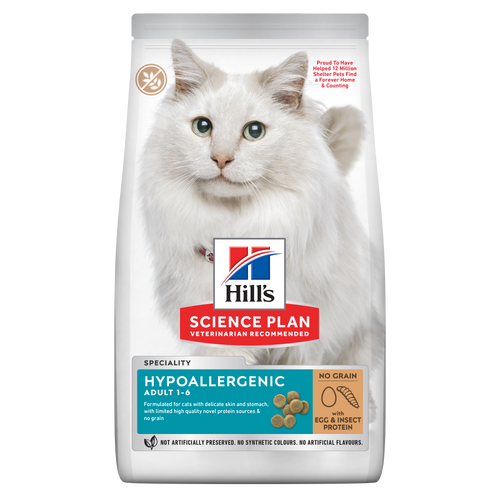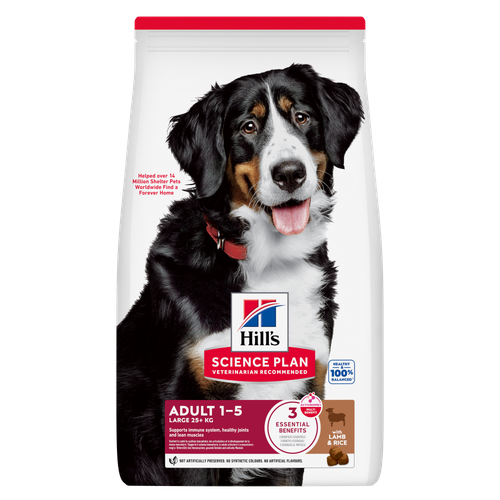
-
Find the right food for your petTake this quiz to see which food may be the best for your furry friend.Find the right food for your petTake this quiz to see which food may be the best for your furry friend.Featured products
 Perfect Digestion Large Breed Puppy Food
Perfect Digestion Large Breed Puppy FoodPrecisely balanced nutrition with Hill's ActivBiome+ prebiotic blend actively contributes to supporting digestive health and overall well-being to help your pet feel their best
Shop Now Perfect Digestion Small & Mini Adult Dog Food
Perfect Digestion Small & Mini Adult Dog FoodHill's Science Plan Perfect Digestion Small & Mini Breed Adult Dog Food with Chicken & Brown Rice supports ultimate digestive well-being & a healthy microbiome.
Shop Now Small & Mini Mature Adult 7+ Dog Food
Small & Mini Mature Adult 7+ Dog FoodHill's Science Plan Small & Mini Breed Mature Adult Dog Food with Chicken is a complete pet food, specially formulated with ActivBiome+ Multi-Benefit Technology.
Tailored nutrition to support graceful ageing in small dogs. Specially made with a synergistic blend of nutrients for energy & vigor.Shop NowFeatured products Kitten Food
Kitten FoodTender chicken chunks in gravy for kittens, with omega-3s for healthy eye & brain development and high-quality protein to support muscle growth. With balanced minerals to promote strong bones & teeth.
Shop Now Hairball & Perfect Coat Adult Cat Food
Hairball & Perfect Coat Adult Cat FoodHill's Science Plan HAIRBALL & PERFECT COAT Adult cat food with Chicken is specially formulated to effectively help avoid hairball formation in adult cats while promoting a beautiful coat. Thanks to its mix of essential Omega-6 fatty acids, this food benefits the cat's skin and fur keeping them healthy and shiny. Our Advanced Fibre Technology helps reduce hairballs by naturally promoting their passage through the gut. This food is formulated with high-quality protein for a perfectly balanced, great-tasting recipe.
Shop Now Hypoallergenic Dry Cat Food
Hypoallergenic Dry Cat FoodHILL'S SCIENCE PLAN Hypoallergenic Adult cat food with egg & insect protein is a complete pet food for adult cat 1–6 years old. It's formulated for cats with delicate skin and stomach, with limited high quality novel protein sources & no grain.
Shop Now -
Dog
- Dog Tips & Articles
-
Health Category
- Weight
- Food & Environmental Sensitivities
- Urinary
- Digestive
- Joint
- Kidney
-
Life Stage
- Puppy Nutrition
- Adult Nutrition
- Senior Nutrition
Cat- Cat Tips & Articles
-
Health Category
- Weight
- Skin & Food Sensitivities
- Urinary
- Digestive
- Kidney
-
Life Stage
- Kitten Nutrition
- Adult Nutrition
Featured articles The Right Diet For Your Pet
The Right Diet For Your PetLearn what to look for in healthy pet food & nutrition, including ingredients, quality of the manufacturer, your pet's age, and any special needs they have
Read More Understanding Your Pet's Microbiome
Understanding Your Pet's MicrobiomeLearn what a pet's microbiome is, how it contributes to your pet's gut & overall health, and why nutrition is important in maintaining healthy microbiomes.
Read More Pet Food Storage Tips
Pet Food Storage TipsWhere you store your cat and dog food can make a big difference in the quality and freshness once it is opened. Here are some common questions and recommendations for optimal storage for all of Hill’s dry and canned cat and dog food.
Read More -



There are so many more opportunities to take your puppy away with you on holiday these days. In fact, in most newsagents you'll find publications that list holiday accommodation where you and your pet will be made most welcome.
You can even take your pet on holiday abroad, thanks to the Pet Passport Scheme (PETS). This means that pet dogs living in the UK can go to, and return from, European countries without quarantine. But organising a pet passport can take about eight months, so planning ahead is essential.
It almost goes without saying, but whether you intend to take your puppy on holiday at home or abroad, you should ensure he has the correct vaccinations before travelling, and that they're up-to-date. If you're in any doubt, then please consult your vet.
Preparing your puppy for the journey
It's essential that your puppy is fit and healthy before he travels. However, during long journeys, dogs can become sick and show symptoms of distress. It is advisable to ask your vet about travel sickness remedies, even tranquillisers if your dog isn't a good traveller.
And as you'd expect, it's important to get your puppy used to the car before he travels. Once he's used to his household surroundings, place him in the car to sleep for half an hour, or allow him to explore the inside. When he's used to the surroundings, you can take him on short journeys, gradually increasing their length over time.


Tasty Tips
Before you hit the road
Your puppy should be fed well in advance of any travel. If this isn't possible, you should consider putting off feed time until you arrive at your destination. And make sure he's microchipped, wearing a collar and tag with your address and contact numbers.
Basically, microchipping is law, is an effective and simple way of linking your pet to you, and is a virtual guarantee of you both being re-united if he gets lost, strays or is stolen. A simple injection of a tiny microchip the size of grass seed is inserted under the skin. This cannot be seen but it can be read by a scanner. Your vet will be happy to give you more information about microchipping.
Now that you're on your way
Your puppy should always be transported in complete safety, preferably in a purpose-built cage safely secured to the car (in the luggage department if you drive an estate car). However, if it's not possible to put your puppy in a cage, he should be securely placed in the back of the car in a special dog seatbelt or harness. Alternatively, in an estate or hatchback, put him in the space behind a fitted dog guard. But always remember that your pet should be able to stand up and turn around, and sit and lie down comfortably. And please, never shut him in the boot or keep him in the front unless he's secured.
Give your puppy a break
If you're going on a long journey, take a break; stop the car and let your puppy have a drink of water and a little exercise. If you're making a short stop, for a meal or the toilet, never leave your pet in a hot, unventilated car; leave it in the shade with a window partly open. And don't forget: The sun's position changes throughout the day. Your car may have been in the shade an hour ago, but could be in the full glare of the hot sun now.


One of our staff authors prepared this article for you
Related products

Hill's Science Plan Small & Mini Breed Mature Adult Dog Food with Chicken is a complete pet food, specially formulated with ActivBiome+ Multi-Benefit Technology.
Tailored nutrition to support graceful ageing in small dogs. Specially made with a synergistic blend of nutrients for energy & vigor.

Precisely balanced nutrition with Hill's ActivBiome+ prebiotic blend actively contributes to supporting digestive health and overall well-being to help your pet feel their best

Hill's Science Plan Large Breed Adult Dog Food with Lamb & Rice is a complete pet food, specially formulated with ActivBiome+ Multi-Benefit Technology.
This food is specifically designed to fuel the energy needs of large breed dogs during the prime of their life.

Hill's Science Plan Perfect Digestion Small & Mini Breed Adult Dog Food with Chicken & Brown Rice supports ultimate digestive well-being & a healthy microbiome.
Related articles

Learn about snake bites on dogs, including clinical symptoms to look for, what to do if you think your dog was bitten, and treatment & prevention options.

Discover how the field of dog science is giving us more and more insights into the inner workings of our furry best friends.

Discover the causes, signs, and treatments of kidney disease in dogs and find methods of supporting your dog's kidney health. Learn more at Hill's Pet South Africa.

Dog obesity is a significant problem - learn more about helping your dog become trimmer and healthier through improved nutrition.

Put your dog on a diet without them knowing
Our low calorie formula helps you control your dog's weight. It's packed with high-quality protein for building lean muscles, and made with purposeful ingredients for a flavorful, nutritious meal. Clinically proven antioxidants, Vitamin C+E, help promote a healthy immune system.
Put your dog on a diet without them knowing
Our low calorie formula helps you control your dog's weight. It's packed with high-quality protein for building lean muscles, and made with purposeful ingredients for a flavorful, nutritious meal. Clinically proven antioxidants, Vitamin C+E, help promote a healthy immune system.

